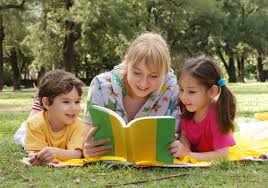
How can you encourage your child to read? According to research conducted by King’s College London, most children learn better outdoors. They feel more curious, motivated, and happy to concentrate when they’re outside.
Share stories under a tree, in a tent, on a picnic blanket or snuggled up in a pile of cushions and blankets. With a bit of preparation you can go out whatever the weather. The worse the weather, the more exciting it can be!
Find stories and non-fiction books your child will love by browsing together at the library, and by picking out books that you think they will enjoy. Extend your child’s reading with activities linked to books, and join in with activities yourself – enjoyment and enthusiasm are infectious.
Here are some examples of how to get your child interested in reading through story themes.
Potions
Picture books:
Meg and Mog by Helen Nicoll and Jan Pienkowski
Potion Commotion by Peter Bently and Sernur Isik
Paperbacks:
Harry Potter and the Philosopher’s Stone
The Worst Witch by Jill Murphy
Activity
The child makes a magic potion by mixing natural ingredients (stones, soil, weeds, leaves) with water. Add a sprinkle of bicarbonate of soda and a dash of vinegar for a magical fizz. Encourage the child to jot down the ingredients on a sparkly notepad as they go.
Once the potion is made, the child writes a recipe, giving it a name e.g. ‘Invisibility Potion’, ‘Wishing Juice’. The child reads their recipe to you. If you have written a recipe too, you can swap and read each other’s.
Monsters
Picture books:
Monsters Love Underpants by Claire Freedman
Not Now Bernard by David McKee
Paperbacks:
Fing by David Walliams and Tony Ross
Tom Gates: What Monster? By Liz Pichon
Activity
Make a monster by pressing clay onto a tree and adding natural materials for features. The child writes a fact card for their monster detailing the monster’s name, age, special powers, what it looks like, what it eats, where it lives, and what it likes to do. Ask the child to read their fact card (and yours too, if you have joined in).
Picnics
Picture books:
Florentine and Pig Have a Very Lovely Picnic by Eva Katzler
The Teddy Bears Picnic by Gill Guile
Paperbacks:
The Enchanted Wood by Enid Blyton
The Wind in the Willows by Kenneth Grahame
Activity
Support the child to read and follow instructions from a children’s cookbook to make picnic treats (Florentine and Pig contains recipes). Write a picnic shopping list together and, as you shop, encourage the child to read and follow their list.
Before the picnic, the child writes invitations to toys or friends. After the picnic give the child an attractively presented thank you letter from a guest (the letter should be at the child’s reading level).
Gentle Giants
Picture books:
George’s Amazing Adventures: Jellybeans for Giants by Adam & Charlotte Guillain
The Smartest Giant in Town by Julia Donaldson and Axel Scheffler
Paperbacks:
The BFG by Roald Dahl
The Gentle Giant by Michael Morpurgo
Activity
Outside, hide a letter from the story giant. The letter should provide details about the giant and its life and also ask the child questions about themselves.
The child finds the letter by following props or footprints relevant to the story. For instance, The Smartest Giant in Town props could be a trail of discarded clothes.
Once the child has read the letter, they write a reply to the giant.
Treasure!
Picture books:
Mr Men: Adventure with Pirates by Roger Hargreaves
The Pirates of Scurvy Sands by Jonny Duddle
Paperbacks:
Treasure Island by Robert Louis Stevenson
Scarlet Silver: Swashbuckle School by Sarah McConnell and Lucy Courtenay
Activity
Write and hide clues that lead the child to hidden treasure (perhaps chocolate coins). Make the clues descriptive, incorporating some directional language: ‘Turn right by the garden table and walk towards the flower bed’. For extra engagement, write some clues in secret writing.
Once the child has completed the treasure hunt, they could create one for you to follow!
What else can you do to encourage a reluctant reader?
At Tutor My Kids we believe that with the right support reluctant readers can be inspired to read for pleasure.
- Set an example. If your child sees that you love reading, they soon will too.
- Read to them. They are likely to appreciate exciting stories that are above their current reading level.
- Motivate children through their interests. Encourage them to choose books independently, and at the same time introduce them to books you think they will enjoy.
Remember, writing is everywhere – indoors and outdoors. It’s on signposts, labels, instructions, cereal boxes, flyers and so on. Wherever they are, encourage your child to engage with the written word and they will soon be a fluent, interested reader.